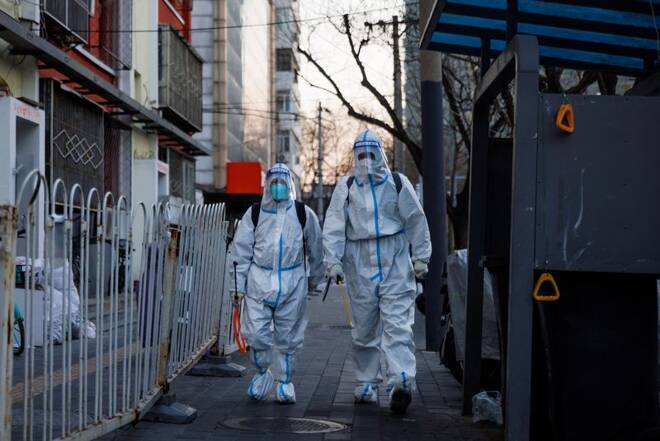Advertisement
Advertisement
China set to ease COVID curbs further as markets cheer change of tack
By:
By Ryan Woo and Bernard Orr BEIJING (Reuters) - A patchwork easing of the world's toughest COVID-19 curbs sowed confusion across China on Monday, spurring hopes for more clarity as officials shift tone on the dangers posed by the coronavirus in the wake of last month's unprecedented protests.
By Julie Zhu and Ryan Woo
HONG KONG/BEIJING (Reuters) – China is set to announce a further easing of some of the world’s toughest COVID curbs as early as Wednesday, sources said, as investors cheered the prospect of a policy shift that follows widespread protests and mounting economic damage.
Three years into the pandemic, China’s zero-tolerance measures, from shut borders to frequent lockdowns, contrast sharply with the rest of the world, which has largely decided to live with the virus.
The strict approach has battered the world’s second-largest economy, put mental strain on hundreds of millions and last month prompted the biggest show of public discontent in mainland China since President Xi Jinping took power in 2012.
Although last month’s protests largely subsided amid a heavy police presence across major cities, regional authorities have since cut back on lockdowns, quarantine rules and testing requirements to varying degrees. Top officials have also softened their tone on the dangers posed by the virus.
The financial hub of Shanghai announced on Monday night that it would remove COVID testing requirements for people to enter most public places from Tuesday.
And a new set of nationwide rules is due to be announced soon, two sources with knowledge of the matter told Reuters, paving the way for more coordinated easing.
Beijing is also weighing whether to scale down its management of the virus to reflect the less serious threat it poses as early as January, the sources added.
More broadly, analysts now predict China may drop border controls and re-open the economy sooner than expected next year, with some seeing it fully open in spring.
“Though we are hopeful too, we caution that the road to reopening may be gradual, painful and bumpy,” wrote Nomura chief China economist Ting Lu in a research note on Monday, adding that China did not appear to be well prepared for a massive wave of infections.
As infections rise, putting pressure on China’s medical infrastructure, mild and asymptomatic cases should quarantine at home, Feng Zijian, former deputy head of the Chinese Centre for Disease Control and Prevention, told The Paper.
Those who have not completed their basic immunisation or obtained their booster shots should do so as soon as possible, especially the elderly and vulnerable, Feng told the Shanghai government-backed news outlet in an interview.
But the patchy loosening over the past week has left some in China scared of being caught on the wrong side of fast-changing rules.
Yin, who lives in a small city near Beijing, said her in-laws had come down with a fever and she had a sore throat but they did not want to be tested for fear of being thrown into government quarantine.
“All we want is to recover at home,” she told Reuters, speaking on condition of anonymity.
The yuan jumped to its strongest level against the dollar since mid-September amid a broad market rally as investors hope the unwinding of pandemic curbs will brighten the outlook for global growth.
In another hopeful sign, a source at Apple supplier Foxconn told Reuters the firm expected its COVID-hit Zhengzhou plant – the world’s biggest iPhone factory – to resume full production this month or early next.
Economic data underscored the damage done by the curbs, as services activity shrank to six-month lows in November.
Changing message
Alongside the easing in different cities, Vice Premier Sun Chunlan, who oversees China’s COVID efforts, said last week the ability of the virus to cause disease was weakening.
That change in messaging aligns with the position held by many health officials around the world for more than a year.
In recent days, major cities across China have continued loosening measures.
Among them, the eastern city of Nanjing dropped the need of a COVID test to use public transport. So did Beijing, though entry to many offices in the capital still requires negative tests.
“I can’t feel a very noticeable change yet,” said Randle Li, 25, a marketing professional in Beijing. Li said his firm still required him to test every day to enter the office.
Elsewhere, as testing requirements have eased, official figures of new infections have also dropped.
Hu Xijin, a prominent commentator and former editor-in-chief of state-run tabloid Global Times, said in a blog that some official tallies were likely underreporting the spread of the virus because of lower testing rates.
While the protests have died down, frustration can still boil over, as events in the central city of Wuhan, where the virus first emerged in late 2019, showed this weekend.
On Saturday, people pushed down barriers in an apparent attempt to break out of a lockdown at a garment industrial park, video clips posted on Twitter showed.
Then on Sunday, dozens of students stood in the rain outside a university in the city demanding greater “transparency” in COVID policies, other videos showed.
Reuters was able to verify that the incidents happened in Wuhan.
(Reporting by Ryan Woo, Bernard Orr and Martin Quin Pollard in Beijing and Julie Zhu and Kevin Huang in Hong Kong; Writing by John Geddie and Greg Torode; Editing by Clarence Fernandez and Nick Macfie)
About the Author
Reuterscontributor
Reuters, the news and media division of Thomson Reuters, is the world’s largest international multimedia news provider reaching more than one billion people every day. Reuters provides trusted business, financial, national, and international news to professionals via Thomson Reuters desktops, the world's media organizations, and directly to consumers at Reuters.com and via Reuters TV. Learn more about Thomson Reuters products:
Advertisement
